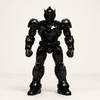Redefining Autonomous Defense Through Precision and Intelligence



Project Axis is CriusCo’s internal codename for our most advanced autonomous defense system to date — a fully integrated, modular turret platform that represents the convergence of real-time machine learning, adaptive sensor fusion, and battle-grade mechanical systems.
Vision and Purpose
Axis was born from the need for a scalable, intelligent defense solution that can operate with or without human oversight in dynamic environments. Traditional automated defense systems are often static in design and rigid in application. Axis disrupts this legacy approach by offering real-time decision-making, self-contained battlefield awareness, and physical adaptability that extends well beyond current norms.
Platform Architecture
The Axis platform consists of three core hardware modules:
-
Fire Control Unit (FCU) – a gimbal-stabilized mounting system supporting a variety of kinetic and non-kinetic payloads. It includes:
- High-torque electromechanical actuation (servo-magnetic drive with absolute encoders)
- Reinforced composite armor shielding
- Modular weapon rails compatible with autocannons, directed-energy emitters, and non-lethal crowd control systems
-
Perception Suite – the sensor array that enables Axis to perceive and interpret its environment, composed of:
- Dual-spectrum EO/IR imaging systems (16K visual, FLIR thermal)
- LIDAR + millimeter-wave radar fusion
- Acoustic triangulation for ballistic source detection
- Embedded environmental sensors (humidity, barometric pressure, IR signature dampening feedback)
-
AI Subsystem – the onboard neural processing unit trained on both synthetic and live combat datasets, featuring:
- 37-layer convolutional neural network tuned for object detection, tracking, and classification
- Adaptive threat evaluation and priority resolution
- Secure embedded OS with encrypted over-the-air model updates
- Energy-aware processing modes to optimize for thermal dissipation and battery longevity in field conditions
Tactical Autonomy and Behavior
Unlike most static turrets that rely on human-issued commands, Axis can:
- Identify, classify, and prioritize multiple simultaneous threats using probabilistic inference models
- Auto-adjust its targeting heuristics based on changing mission parameters and real-time performance feedback
- Predict enemy movement trajectories using Bayesian motion prediction algorithms
- Seamlessly switch between manual, assisted, and fully autonomous control modes
Axis supports multiple mission profiles, including:
- Fixed perimeter defense (stationary mount, persistent overwatch)
- Vehicle-mounted escort configurations (armored convoy integration)
- Mobile ground-based deployment (via tripod or portable chassis)
Power and Communications
The Axis unit is powered via dual-mode supply:
- Primary: on-grid or vehicle-integrated power coupling (24–48V DC)
- Secondary: internal graphene supercapacitor bank with solar trickle charging for up to 8 hours of silent runtime
Communication interfaces include:
- MIL-STD-1553 and CAN bus support
- Encrypted RF (LPI/LPD waveforms)
- Satellite fallback with compression-layer telemetry
Field Deployment and Trials
Prototypes of Axis have already undergone 200+ hours of stress testing, including:
- Thermal cycles from −40°C to 60°C
- Live fire with integrated M230 chain gun
- Simulated jamming and spoofing scenarios
- Mobility trials on incline platforms and amphibious testbeds
Results indicate 94% target acquisition accuracy in cluttered visual environments and a 29ms mean reaction time to emergent threat signatures — outperforming our baseline control systems significantly.
Future Roadmap
Axis is currently in Phase III of validation testing, with planned milestones including:
- Swarm networking for multi-unit coordinated response
- Integration with UGV and drone systems
- Expansion into civilian applications (e.g., critical infrastructure defense, wildlife deterrence)
The final product name for Project Axis will be revealed upon formal release, but the core philosophy remains unchanged: precision, adaptability, and machine-native combat logic.
CriusCo Robotics Division